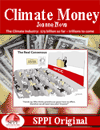|
|
On fire — Ann Widdecombe lays out the situation.
The only kind of Brexit is a clean break.
October 18th 2019
“The Brexit party will take Leave and nothing else.”
“We gave Europe their freedom and in return they want to take ours.”
She’s 72, and has studied Latin, Philosophy at Oxford. She was a Minister in the John Major Government. What a powerhouse.
Bring on an election!
h/t Jim Simpson.
9.6 out of 10 based on 83 ratings
Add another billion to the cost of the Renewable Energy Target?
In the last few days Bluescope Steel (formerly BHP) has confirmed it will spend US$700m (AU$1b) to expand it’s North Star steel mill in Ohio. So there are multiple headlines. But back in February CEO Mark Vassella explained exactly why they were thinking of it, and his first reason was “energy prices”. Last week, high energy prices were even “a tragedy” for Australian manufacturing. This week however, he’s clarified his position by muddying it up. Now there other reasons and the solution is to fix our gas prices. He’s backpedaling and tossing quotes that happen to help the renewables industry.
Perhaps he’s been heavied by his PR and strategy team? Now he’s saying that energy costs matter, but labor costs do too and “we weren’t ever going to put another steel mill in Australia”. He’s even saying energy costs “did not play a role” — the complete opposite. These will become the quotes the renewable energy fans rely on. Apparently, now what he really wants is cheaper gas — which requires a socialist government-driven solution to fix gas prices, and it’s safe for anyone to mention anything that requires […]
Remember when we were told coal was dying?
Donald Trump is changing the rules which will keep older cheap coal plants running.
Trump ditches sole climate rule that aimed to reduce coal plant pollution
Emily Holden, The Guardian
Donald Trump’s administration is finalizing plans to roll back the US government’s only direct efforts to curb coal-fired power plant pollution that is heating the planet.
Trump’s Environmental Protection Agency will replace an Obama-era climate change rule with a regulation that experts warn could help some of America’s oldest and dirtiest coal plants to keep running.
His agencies have slashed programs designed to limit carbon dioxide from power plants, cars, and trucks, and encouraged oil drilling and coal mining.
Democrat states are expected to challenge the rule in courts, but Trump’s team argues that it doesn’t have the legal authority to regulate climate. Who does? God, maybe. If Trump wins that court case a whole lot of climate gravy may evaporate.
Trump will kill as many 80,000 people
One minute we’re talking about a pollutant that isn’t. Next thing, it’s a totally different pollutant that has nothing to do with CO2:
June 20th, 2019 | Tags: Coal, USA | Category: Economics |  Print This Post | | Print This Post | |
A big new study by electricity grid nerds (and I mean that in the nicest possible way) shows that after all the money and pain of 20 years of forced transition Australia’s electricity has shifted from 85% coal powered to 75% coal powered, which cost billions and as a bonus, made electricity more expensive and unstable. We drove out some brown coal, but swapped it for black coal. Instead of ousting coal power, the extra solar and wind power replaced some gas and hydro.
The authors are genuine independent experts, and the report is incredibly detailed — so this is rare — but still suffers from serious drawbacks:
The team doesn’t question the need for an artificial expensive transition. Almost all the problems they describe are caused by government policies that task our grid with changing the climate as well as producing cheap and reliable electricity. In a grid being ruined by inept policy, the implied solutions almost all involve more regulation and government policy. If our gas prices are too high we could ban sales overseas, but then we lose the export income. The left hand steals from the right. The free market solution is to use another fuel, […]
Behold, the Victorian Govt are proving yet again that Soviet-style electricity management can crush lives, hopes and wallets. The free market is never as cruel and destructive as one run on “good intentions” or the desire to win virtue-signaling fashion parades.
The invisible hand of the market was replaced with Daniel Andrews whimsy. This might work if he was smarter than the collective brains of 5 million people. Apparently Andrews assumes serfs people don’t understand the true value of solar panels and the benefits of creating jobs in China, so he has mandated glorious subsidies in the hope of getting nice weather one day, and the desperate punters took them up in droves. The industry boomed. But now they’ve temporarily halted the free gifts, orders have disappeared as the free market returns to accurately valuing solar installations. So the workers are being sacked. The rebates will come back again in July, so business-owners somehow need to get a different income stream for two months, survive the turmoil, and then the golden gravy will run again.
As per usual ABC policy, no free market voices were harmed, interviewed or asked to provide comment:
Victorian solar company reeling after popular rebate […]
Millenials are aged 25 – 39. In Australia four out of five are not even “familiar” with Mao. Half have never heard of him, even though he caused the deaths of twice as many people as Adolf Hitler.
Political ideologues control our education system. We teach kids identity politics, and how to control the weather with light globes, but not the most important political lesson of the 20th Century.
We won the cold war, then lost the peace.
Why Millenials are embracing Socialism
Tom Switzer, Sydney Morning Herald
The survey evidence is clear. In a YouGov poll commissioned by the Centre for Independent Studies last year, 58 per cent of Australian millennials have a favourable view of socialism, with only 18 per cent having an unfavourable one. These findings reflect Millennial attitudes in Britain and the US.
What’s going on?
Part of the problem is plain ignorance. Most Millennials were hardly alive when Ronald Reagan called the Soviet Union an “evil empire”.
According to the CIS poll, only 26 per cent of Millennials are familiar with Vladimir Lenin and 34 per cent with Joseph Stalin. Only 21 per cent of […]
Australia Wins The Global Patsy Award 2019
The Brookings Institute released a report that claims everyone is better off economically by sticking to Paris, but check out the devastating graphs. Economically, everyone is a loser, but the three biggest losers are Australia, Russia and OPEC.
Australia is doing more, paying more, suffering more and yet will make almost no difference to the global emissions tally in anything other than a purely symbolic impress-your-dinner–guests kind of way.
If Australia left the Paris Agreement, even the left leaning Brookings Institute can’t find much difference in total global man-made emissions. Australia is forcing the renewables transformation faster than anywhere else, it will lose GDP, wages, jobs, investment, and the dollar will fall. All that, and no one could even tell the difference between Paris with Australia, and Paris without.
Clearly Australian negotiators at the UN are incompetent on a whole new scale. If they had Australian’s interests at heart, even a little bit, they would have done this study themselves, and gone to Paris with some realistic comparative data to argue that we are cutting too fast and paying too much. Finalists for most useless Global Negotiator of the Decade are Kevin Rudd, […]
Opportunity costs are the most invisible costs in the world.
Purely hypothetically, if you wanted to nobble a competing country, you could pay 350.org…
“We know what it takes to stop this industry,” said 350.org’s May Boeve. “It is not a mystery, it is not magical.
Valerie Richardson, The Washington Times
Climate protests cost $91 billion in lost economic activity, chamber study finds
Climate activists fighting to derail pipelines and other energy projects have blocked $91.9 billion in U.S. economic activity and hundreds of thousands of jobs, according to a new report.
See more at: https://www.globalenergyinstitute.org/infrastructure-lost
There is no Economy B. Once we have wrecked this one….
The report analyzed 15 targeted projects, including the hotly contested Keystone XL pipeline, Constitution Pipeline, and Oregon LNG terminal, as well as New York Gov. Andrew Cuomo’s 2014 fracking ban.
In addition to $91.9 billion in lost economic activity, the protests cost nearly 730,000 job opportunities and $20 billion in tax revenue to federal, state and local governments.
…the U.S. surpassed Russia this year to become the world’s largest crude oil producer and has led the world in […]
The advantage of communist autocrats is that they can create government havoc so much more efficiently.
The Chinese solar boom was so big it became the world’s largest solar market. It was so big it pushed up global “clean energy” investment to a record high. China became the veritable show pony of the solar spruikers: “leading the world in clean energy investment”. Mashable tells us it was so big “the solar boom could be seen from space“.
But the star advertisement for renewable glory was all based on subsidies:
The Chinese solar boom was “pretty significant”
A couple of months ago the Chinese government admitted they were cutting the subsidies to make electricity cheaper again for consumers. That hit the stock market. Now projects are being cancelled and orders are drying up for the hapless manufacturers.
The free market might be telling us something China’s solar industry is at a crossroads
“Without subsidies there’s no return on investment for over a decade, so investors and property owners aren’t interested in distributed solar. With subsidies it only takes seven years to recoup the investment,” he adds.
China’s solar manufacturers are unhappy with recent government policy changes […]
Wow. Wait til word gets out. This is dynamite.
Chinese Bitcoin miners are reopening the Hunter Valley coal power station called Redbank in NSW. They have a deal that gets around our gargantuan, mismanaged grid by buying coal power direct for 8c/kWh, while Australians in the same place pay 28c/kWh.
This is exactly the nightmare the head of the Australian Energy Management Organisation (AEMO) spoke of just last week — that “big players could abandon the grid”. That’s a degenerate spiral leaving a shrinking pool of suckers to pay for the inefficient, bird-killing, blackout prone, witchdoctor grid.
Bitcoin mining’s growing demand for cheap energy revived a shuttered coal mine
Ashat Rathi, Quartz
Consumers there pay, on average, $A0.28 ($0.22) per kilowatt-hour (kWh) for electricity. But Hunter Energy, which owns Redbank, are offering the crypto miners electricity at a fraction of the cost. The “first-of-its-kind” deal, as the Age puts it, will see the crypto miners pay only A$0.08 per kWh in the day and A$0.05 per kWh at night. Hunter Energy told the Age that the price is feasible because the electricity produced at the coal power plant would go straight to the crypto miners, bypassing—and […]
The Australian Fake Free market is so screwed. What asset is worth more in the trash-can than sold to a willing bidder? AGL is the definition of Predatory Capitalism.
Everyone is talking about Liddell. The old coal plant is on the chopping block in 2022 and we can see the electricity price rise coming from here.
People in Australia are going without their veggies to pay for electricity. Liddell coal plant makes cheap electricity (like old coal plants everywhere). This is a problem that would solve itself if not for Malcolm Turnbull, the RET, and the AEMO. It takes a lot of money and whole fleets of bureaucrats to stop the free market fixing this by default.
AGL is the largest coal-fired producer in Australia, but it’s also the largest generator in toto and the largest investor in renewable energy on the Australian Stock Exchange. Spot the conflict of interest? The company controls 30% of the generation in our two largest states, and 40% in South Australia. The man in charge of AGL – Andy Vesey — formerly of New York, earns $6.9 million a year, and can probably afford to pay his own electricity bill. But as Tony Cox […]
Electricity prices declined for forty years. Obviously that had to stop.
Here’s is the last 65 years of Australian electricity prices — indexed and adjusted for inflation. During the coal boom, Australian electricity prices declined decade after decade. As renewables and national energy bureaucracies grew, so did the price of electricity. Must be a coincidence…
Today all the hard-won masterful efficiency gains of the fifties, sixties and seventies have effectively been reversed in full.
Indexed Real Consumer Electricity Prices, Australia, 1955-2017.
For most of the 20th Century the Australian grid was hotch potch of separate state grids and mini grids. (South Australia was only connected in 1990). In 1998 the NEM (National Energy Market) began, a feat that finally made bad management possible on a large scale. Though after decades of efficiency gains, Australians would have to wait years to see new higher “world leading” prices. For the first years of the NEM prices stayed around $30/MWh.
But sooner or later a national system is a sitting duck for one small mind to come along and truly muck things up.
Please spread this graph far and wide.
Thanks to a Dr Michael Crawford who did the original, […]
A fairly crappy investment in every sense — even as a “subsidy farmer”:
…renewable energy proponents say individual consumers like Mr Pulford could play an increasingly important role as citizen investors.
“I say it is a little bit gold plated,” Mr Pulford says of his $20,000 investment.
‘The new system was installed last month and he is already generating enough power to run all his home energy needs, charge his son’s hybrid SUV and sell excess back to the grid. “It ranges between $2 to about $1.90 a day for energy and that can be with the clothes dryers and bar heaters on.”
Mr Pulford said he expects to pay off the investment within 14 years.
He’s excited that his electricity bill is only $700 a year, after laying out twenty grand. After 14 years his “investment” will start to pay off, assuming the batteries are still running, the solar panels are clean, and the inverter didn’t need replacing. Those battery warranties, at best, are ten years. He might get lucky. Without subsidies, his “pay-back time” would be something like 30% longer.
In the ACT, 250 homes with Reposit technology […]
What other heavily subsidized industry brags about its ability to provide a product for one quarter of the time it’s needed? Vale sunny-day-solar!
Pick a day, an hour, and what are the chances solar will be there for you? A lot less than one in four, because last Monday’s peak in South Australia was an all time record. Every day in the last year was worse.
And so much for cheap… the price when solar power peaked was still close to $50/MWh. Compare that to most of the years of the national electricity market operating when average prices were $30/Mwh.
The price dip at 6am (the black-line bottomless gully), has nothing to do with solar, but was caused by wind power. Far from being useful, essential, or productive, solar and wind power are playing havoc with a normal market, destroying the chance for cheap, reliable energy to find a place. As long as we force the market to accept this non-dispatchable supply, we are actively punishing reliable power. What investor in reliable energy would look at this and head to South Australia?”
Giles Parkinson was excited at Reneweconomy: Rooftop solar provides 48% of South Australia power, pushing grid […]
It’s a very well written article: Bonackers vs. Big Wind by Robert Bryce. h/t Andrew. The good news is that opponents of wind power are having a lot of success onshore. The bad news is that the renewables industry is pushing offshore instead, but fishermen don’t want them either, and families that have been fishing the same areas for 300 years are up in arms.
“The South Fork fishermen are fighting to preserve their access to some of the most productive fisheries in the world.”
Some eye-opening numbers:
Obama set a target of 10GW of offshore wind power by 2020. But right now there is only 30 MW. It’s 9,970MW short. The offshore push is on. To replace a single nuclear generator will take 45 offshore wind plants. Offshore generation costs as much as three times what gas power costs per KWh.
They face big money renewables proponents — not just rich beachfront homeowners, but large corporations who want tax credits worth millions, and groups like Norwegian oil giant Statoil ASA, plus the Sierra Club and Natural Resources Defense Council (NRDC). Governor Andrew Cuomo has a goal of “producing 50 percent of the state’s electricity from renewables by […]
Remember the Electrical Eclipse-Fear? For months, people were coached to use less electricity during the eclipse for fear that the grid might fall over as marvelous new-revolution-solar stopped working. The media were selling the message that we might not cope without solar. I figured this would be as big a threat as a cloudy day (but easier to prepare for.).
So after all the spin, what happened? Electricity was massively oversupplied, and spot prices went negative.
Apparently people went outside to watch the sky. (At least that’s Southwest Power’s excuse.)
Most of the groups that hyped the fear don’t seem to have mentioned the failure so much:
Why Energy Traders Got the Eclipse So Wrong — Bloomberg
Grid operators and traders thought they were totally prepped for the historic U.S. solar eclipse. There was just this one thing they didn’t completely factor in: “irregular human-behavior patterns.”
That’s the technical definition, from the folks who manage the electricity network at the Southwest Power Pool, for the conduct of millions of Americans who were outdoors ogling the moon shadowing the sun instead of cranking up the A/C in homes and offices.
This was a bummer for […]
What’s the word for competitive-but-needs-a-subsidy? Broke…
One hundred solar PV companies are forecast to collapse in Japan this year alone.
Up to 100 solar PV firms in Japan could face bankruptcy this year, with more than double the number of firms going bust in the first half of this year than the same period in 2016.
According to corporate credit research company Teikoku Databank, which surveys companies across various industries and has produced its third report on solar PV company bankruptcies, 50 companies in Japan’s solar sector have already gone out of business in the first six months of 2017.
While the market overall has rapidly expanded from the launch of the feed-in tariff (FiT) in July 2012, Teikoku Databank acknowledged that there has been a slowdown in deployment in the past couple of years as the government successively made cuts of 10% or more on an annual basis to the premium prices paid for solar energy fed into the grid.
Bankruptcies have doubled in the industry since last year.
Meanwhile Japan plans to build at least 45 HELE Coal Plants.
Check out the map of “coal in versus coal out” in Japan. For […]
There are probably more solar panels in QLD than anywhere else in the world. Back in February last year, the boss of the Queensland state power company announced the awkward result that households with solar panels were using more electricity than those without. Apparently people without solar were turning off the air conditioner because electricity cost too much, but the solar users didn’t have to worry about the cost so much.
Queensland solar homes are using more grid electricity than non-solar, says Energex boss
Feb 2016: Solar-powered homes in south-east Queensland, which boasts the world’s highest concentration of rooftop panels, have begun consuming on average more electricity from the grid than those without solar, the network operator has found.
Terry Effeney, the chief executive of state-owned power distributor Energex, said the trend – which belied the “green agenda” presumed to drive those customers – was among the challenges facing a region that nevertheless stood the best chance globally of making solar the cornerstone of its electricity network.
From October 2014 in Queensland, the average grid electricity use of solar homes started to exceed the average use of people without solar power and stayed higher for the […]
Lately the Five Star Free Market label is just a fake seal of approval for something Unfree
Just as carbon trading has nothing to do with a free market, so it is with monster free trade deals like the TPP. The free market meme won the intellectual debate of the 20th Century, but now its good name gets used and abused to sell the idea it defeated — bigger-government.
A real free market deal has only one page and a bunch of signatures. But it takes a lot of pages to list all the unfree parts and to spell it out in sub-sub-clauses that hurt or help thousands of businesses around the world. Who gets the sweetest deal out of the complexity — the card carrying networkers — those who schmooze up to the right minister or bureaucrat. The people who compete on price or quality alone would win in a real free market, and so would we as customers. Instead the document rewards the gatekeepers, the rulemakers, the industry with the best lobbyists and the monied set who can donate enough to the right causes to get a better deal.
Tipping the scales at 5,544 pages […]
This is what economic growth means, and what some regressives fear so much.
How much would money would you have to be offered to give up the Internet for the rest of your days?
We are all rich beyond the wildest dreams of yesterdays Kings.
Thanks to The Fund for American Studies.
9.5 out of 10 based on 53 ratings
|
JoNova A science presenter, writer, speaker & former TV host; author of The Skeptic's Handbook (over 200,000 copies distributed & available in 15 languages).

Jo appreciates your support to help her keep doing what she does. This blog is funded by donations. Thanks!


 Follow Jo's Tweets
Follow Jo's Tweets To report "lost" comments or defamatory and offensive remarks, email the moderators at: support.jonova AT proton.me
Statistics
The nerds have the numbers on precious metals investments on the ASX
|












Recent Comments